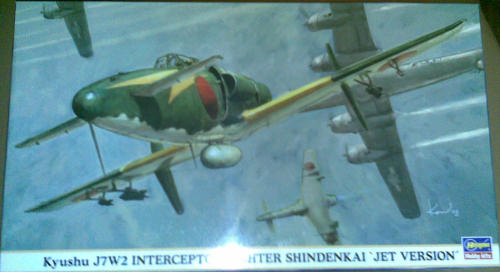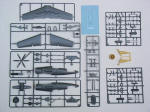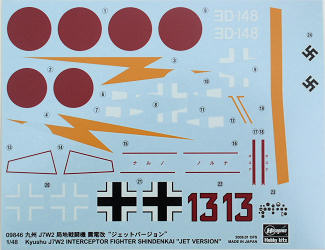
Hasegawa’s
1/48
Kyushu J7W2 Interceptor Fighter
| KIT #: | 09846 |
| PRICE: | $ ? |
| DECALS: | ? |
| REVIEWER: | Bob Kudyba |
| NOTES: |

| HISTORY |
The Japanese Navy had conducted trials on the propeller driven J7W1 Shinden
Interceptor in May 1944; the aircraft was a rather unconventional design in that
it was powered by a large, six-bladed ‘pusher’ type propeller, with shorter main
wings and a smaller set of wings forward at the nose. At first glance, the ‘Shinden’
appeared to be an aircraft driven in reverse. The short wings at the front, or
‘canard’ design, permitted shorter main wings to be fitted to the aircraft and
gave additional ‘lift’. This design feature allowed the overall aircraft to be
reduced in both length and wingspan, with resulting savings in overall weight of
the aircraft.
This aircraft sat on a long, spindly tricycle undercarriage system to permit
ample clearance for its large diameter propeller. The prototype flew three
recorded test flights on 03, 06 and
The Japanese had looked at jet and rocket powered aircraft and both the
Mitsubishi J8M ‘Shusui’ rocket fighter, which resembled the Me-163 and the
Nakajima J9Y ‘Kikka’ that resembled a scaled down version of the Me-262 made
brief test flights around the same time as the flights of the Shinden. With its
tricycle undercarriage and overall body shape, it would seem a logical ‘next
step’ to simply substitute the propeller driven version for an improved
jet-powered one.
Limited information can be obtained for exactly how far progressed this project was at the time of the Japanese surrender, however it joins an increasing array of post-1945 ‘what it’ subjects that are gaining in popularity.
| THE KIT |
 (Thanks
to Tony Hodun, we have images of sprues and decals. Ed)
Hasegawa released a kit of the propeller driven J7W1 version of this kit in 1/48th
scale some 30 years ago. I remember working on this kit many years ago and
marvelling at its long, spindly undercarriage system. It was also a bit fragile
when it came to setting the aircraft on its undercarriage and needed a blob of
plasticine concealed in the nose to ensure it didn’t tilt back onto the two very
small wheels on the underneath of the rear stabiliser fins.
(Thanks
to Tony Hodun, we have images of sprues and decals. Ed)
Hasegawa released a kit of the propeller driven J7W1 version of this kit in 1/48th
scale some 30 years ago. I remember working on this kit many years ago and
marvelling at its long, spindly undercarriage system. It was also a bit fragile
when it came to setting the aircraft on its undercarriage and needed a blob of
plasticine concealed in the nose to ensure it didn’t tilt back onto the two very
small wheels on the underneath of the rear stabiliser fins.
Hasegawa have released this kit as the J7W2 ‘jet version’ by simply adding an
additional set of three parts to replace the propeller driven engine with its
jet counterpart. Probably the easiest ‘conversion’ set ever encountered in a
model. These new parts are enclosed in a separate bag and are moulded in a
sand-yellow colour, as opposed to the overall light grey of the original J7W1
version. 72 parts make up this kit and all parts are packed in a series of
plastic bags to protect them. My example was quite crisply presented with little
evidence of excess ‘flash’.
A rather brief set of instructions is included with the kit, I personally like
to read up on the history of the aircraft before I construct them but Hasegawa
has been pretty reserved on the historical information and data on this
aircraft. Two sets of decals are included with the kit: a (fictitious) ‘307
Naval Flying Group’ from 1947, with the standard ‘JNAF Green and Light Grey
camouflage pattern’ and also an equally fictional Luftwaffe fighter of an
unnamed fighter squadron from 1947 with the late war ‘splinter camouflage
pattern’.
rather brief set of instructions is included with the kit, I personally like
to read up on the history of the aircraft before I construct them but Hasegawa
has been pretty reserved on the historical information and data on this
aircraft. Two sets of decals are included with the kit: a (fictitious) ‘307
Naval Flying Group’ from 1947, with the standard ‘JNAF Green and Light Grey
camouflage pattern’ and also an equally fictional Luftwaffe fighter of an
unnamed fighter squadron from 1947 with the late war ‘splinter camouflage
pattern’.
The three piece canopy can be moulded in the ‘open’ or ‘closed’ mode. However
cockpit detail is not overly represented in this kit.
As an improvement over its propeller-driven earlier version, this kit comes with
large and small anti-aircraft rockets to be fitted under the wings and a ‘drop
tank’ under the central fuselage. A standing pilot figure, similar to the
earlier J7W1, is also included.
| CONCLUSIONS |
This kit will appeal to those of us who like modelling the growing amount of
‘what if’ concepts that are emerging onto the market and, contrasted with its
earlier propeller driven ‘brother’, will no doubt be good talking points for any
display. Presented with the various other Japanese kits of the Mitsubishi ‘Shusui’
rocket plane and the Nakajima ‘Kikka’ they make for interesting subjects.
Kit courtesy of my Credit Card and Hannants.
July 2010
If you would like your product reviewed fairly and quickly, please contact me or see other details in the Note to Contributors.
Back to the Previews Index Page